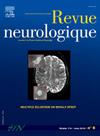An outpatient TIA clinic works! Insights from the creation and the first year of Bordeaux TIA clinic
IF 2.3
4区 医学
Q2 CLINICAL NEUROLOGY
引用次数: 0
Abstract
Background
While the benefits of urgent management of transient ischemic attacks (TIA) are now well established, there is still no consensus on the best care pathway for TIA, particularly regarding hospitalization in an intensive care stroke unit compared to outpatient management in a TIA clinic. The objective of this study was to report the different steps required for the development of a TIA clinic addressing both the healthcare needs as well as architectural and economic constraints of a hospital, then to describe the results of the first year of activity of our TIA clinic.
Method
First, we described the various steps of the development of our TIA clinic and its operational modalities. Then we performed a cohort study of all patients with suspected TIA admitted in the outpatient clinic at Bordeaux University Hospital between November 7, 2022, until November 7, 2023. We analyzed data including characteristics of the population, diagnoses, treatments, hospitalization rate and length of stay. To assess the risk reduction of stroke occurrence three months after TIA, we compared the stroke rate predicted by the ABCD2 score to the observed stroke rate of our population at three months.
Rsults
A total of 507 patients were admitted to the TIA clinic during the first year with a median length of stay of 5 hours. Compared to the period when TIA were hospitalized in our intensive care stroke unit, this represents a tenfold increase in the rate of TIA patients admitted in our stroke unit with a tenfold reduction in the length of hospital stay. Among patients, 13.4% had a minor stroke, 34.5% had a probable TIA, 25.4% had a possible TIA, 26.6% had a differential diagnosis and 11% were subsequently hospitalized in the intensive care stroke unit. Most patients were referred by general practitioners. Our TIA clinic demonstrated a 68% reduction in the risk of stroke after TIA with an observed stroke rate of 0.98% after 3 months compared to the 3.1% predicted by the ABCD2 score.
Conclusion
The opening of a TIA clinic in Bordeaux metropole has significantly improved the management of TIA patients, which was previously inadequate in our territory. This study demonstrated that a hybrid model operating as an outpatient day hospital is effective as it successfully reduced the stroke rate after TIA, while increasing the capacity of TIAs admission to a stroke unit and shortening hospital stays.
TIA门诊有效!从波尔多TIA诊所的创建和第一年的见解。
背景:虽然紧急处理短暂性脑缺血发作(TIA)的好处现在已经得到了很好的证实,但对于TIA的最佳护理途径仍然没有达成共识,特别是与TIA诊所的门诊管理相比,在重症卒中病房住院治疗。本研究的目的是报告TIA诊所发展所需的不同步骤,以解决医院的医疗保健需求以及建筑和经济限制,然后描述我们TIA诊所第一年活动的结果。方法:首先,我们描述了TIA诊所发展的各个步骤及其运作模式。然后,我们对2022年11月7日至2023年11月7日期间在波尔多大学医院门诊收治的所有疑似TIA患者进行了队列研究。我们分析了包括人群特征、诊断、治疗、住院率和住院时间在内的数据。为了评估TIA后三个月卒中发生风险的降低,我们将ABCD2评分预测的卒中发生率与三个月时观察到的卒中发生率进行了比较。结果:第一年共有507例患者入住TIA诊所,中位住院时间为5小时。与TIA在我们的中风重症监护室住院的时期相比,这表明我们中风病房收治的TIA患者的比率增加了十倍,住院时间减少了十倍。在这些患者中,13.4%有轻微中风,34.5%有可能TIA, 25.4%有可能TIA, 26.6%有鉴别诊断,11%随后在中风重症监护病房住院。大多数患者是由全科医生转诊的。我们的TIA临床证明TIA后卒中风险降低68%,3个月后观察到卒中率为0.98%,而ABCD2评分预测的卒中率为3.1%。结论:在波尔多大都会开设TIA诊所,明显改善了对TIA患者的管理,这在我国以前是不足的。本研究表明,作为门诊日间医院的混合模式是有效的,因为它成功地降低了TIA后的卒中发生率,同时增加了TIA住院治疗的能力,缩短了住院时间。
本文章由计算机程序翻译,如有差异,请以英文原文为准。
求助全文
约1分钟内获得全文
求助全文
来源期刊

Revue neurologique
医学-临床神经学
CiteScore
4.80
自引率
0.00%
发文量
598
审稿时长
55 days
期刊介绍:
The first issue of the Revue Neurologique, featuring an original article by Jean-Martin Charcot, was published on February 28th, 1893. Six years later, the French Society of Neurology (SFN) adopted this journal as its official publication in the year of its foundation, 1899.
The Revue Neurologique was published throughout the 20th century without interruption and is indexed in all international databases (including Current Contents, Pubmed, Scopus). Ten annual issues provide original peer-reviewed clinical and research articles, and review articles giving up-to-date insights in all areas of neurology. The Revue Neurologique also publishes guidelines and recommendations.
The Revue Neurologique publishes original articles, brief reports, general reviews, editorials, and letters to the editor as well as correspondence concerning articles previously published in the journal in the correspondence column.
 求助内容:
求助内容: 应助结果提醒方式:
应助结果提醒方式:


